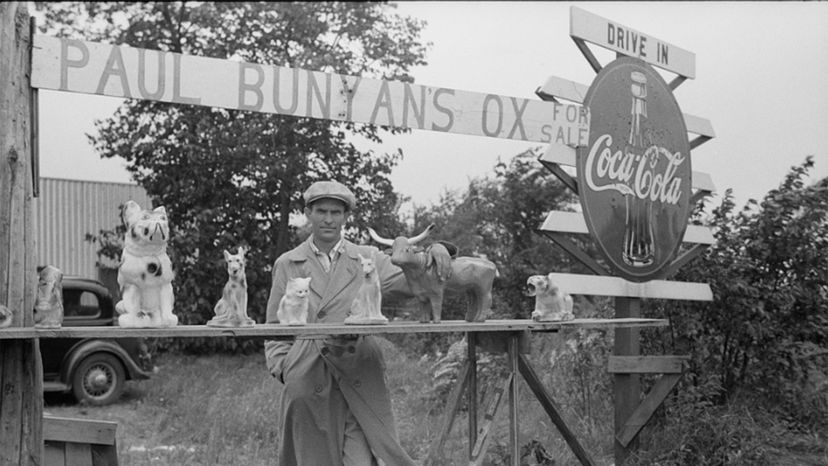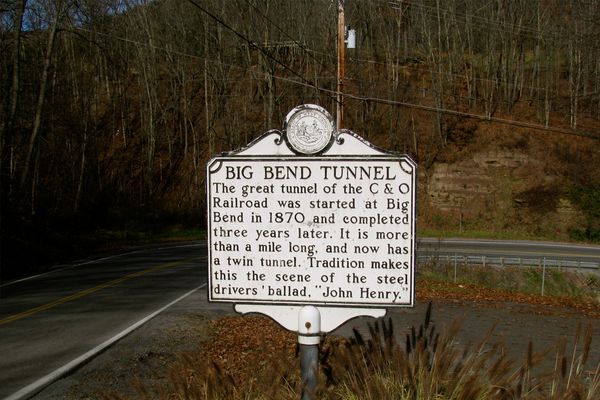
The story of Paul Bunyan, the giant lumberjack, is one of the most enduring tall tales in North America. The folktale is a favorite in children's classrooms and is immortalized in cartoons and tourist attractions all over the United States. But was this based on a real person? Before we answer that, here's a quick refresher on his story.
According to legend, Paul Bunyan was so huge at birth, it took five exhausted storks to deliver him to his parents. When Bunyan was a mere week old, he already fit into his father's clothes. Junior Bunyan downed 40 bowls of porridge a day, they say, and received a big, blue ox named Babe for his first birthday.
Advertisement
Bunyan grew up to become a skilled lumberjack, with Babe — as outsized an ox as Bunyan was a man — always at his side. As a logging team, the two were unbeatable, able to clear forests with amazing speed. At one point, Bunyan headed south and created the Grand Canyon simply by dragging his ax behind him. And Babe? Well, she tromped all around Minnesota's logging country. As she did so, her footsteps filled with water behind her, forming the state's famed 10,000 lakes.
Of course, these are all literally and figuratively tall tales. But are they based in any fact? Perhaps!
The Real Paul Bunyan
Some historians believe Paul Bunyan was based on a real person — a French Canadian logger named Fabian Fournier. Fournier, born in Quebec around 1845, moved to Michigan after the Civil War to take advantage of the high-paying logging jobs that were readily available. His brawn and 6-foot (1.8-meter) height — quite noteworthy in an era when the average American male stood a mere 5 feet (1.5 meters) tall — made him quite intimidating, as did his drinking and brawling. There was even a rumor that he had two sets of teeth, adding to his savage mystique [source: Pruitt].
Fournier, aka Saginaw Joe, died in 1875 during a fight in Bay City, Michigan, a wild town where lumberjacks went to party after every payday. His alleged killer, who struck him in the back of the head with a mallet, was acquitted in a subsequent trial that drew much attention, helping spread the legend of Paul Bunyan to lumberjacking hotspots in Michigan, Wisconsin, Minnesota and beyond.
At some point, Bunyan's story became intertwined with that of another French Canadian war hero by the name of Bon Jean. The tales of Bon Jean and Fabian Fournier combined to create one ferocious, athletic, intelligent lumberjack by the name of Paul Bunyan, with "Bunyan" believed to be a melding of "Bon Jean" [source: Browning].
As the 19th century drew to a close, Paul Bunyan tales appeared to have spread to every logging camp in North America. And with every retelling of the tales, the lumberjacks greatly embellished them. Yet despite the popularity of Paul Bunyan among the lumberjacking community, the general public knew nothing of old Saginaw Joe [source: Chamberlain].
A Legend Is Born
The first mention of Paul Bunyan to people outside of the lumberjacking world came in 1910, when James MacGillivray penned the first of the "Logging Tall Tales" series that would become popular across the nation. The piece ran in the Detroit News-Tribune.
Then, in 1914, the Red River Lumber Company stepped in. The business, which sold its wood to local lumberyards through a national distribution network, developed an advertising campaign for its new mill in California. As part of the campaign, the business hired a man named William Laughead, a former lumberjack, to create a series of engaging pamphlets featuring Bunyan. In the pamphlets, Laughead further exaggerated Bunyan's stories and added to them, but the pamphlets were largely ignored.

Despite the fact that the Bunyan pamphlets bombed in 1914, the company published a revised version of them via a 1922 booklet titled "The Marvelous Exploits of Paul Bunyan." As before, the booklet was intended for lumber industry workers. But the Kansas City Star happened to publish a lengthy review of the booklet, introducing Bunyan to the masses. And the rest, as they say, is history.
The American public quickly became enamored with the massive lumberjack and his colorful bovine companion, especially kids. Soon Bunyan was the subject of comics, books, an operetta and even poems by legendary poets such as Robert Frost and Carl Sandburg. And numerous towns began claiming him as their own, including Bemidji, Minnesota, and Bangor, Maine, the latter of which boasts to have possession of his birth certificate.
Today, many towns hold annual festivals in his honor. You can catch a Paul Bunyan Lumberjack Show in states like Wisconsin and Florida, where lumberjacks and jills compete in activities such as ax-throwing and log-rolling. And June 28 is now known as National Paul Bunyan Day, making Bunyan one of America's quintessential folklore heroes [sources: Brittanica, Yang].
Advertisement


